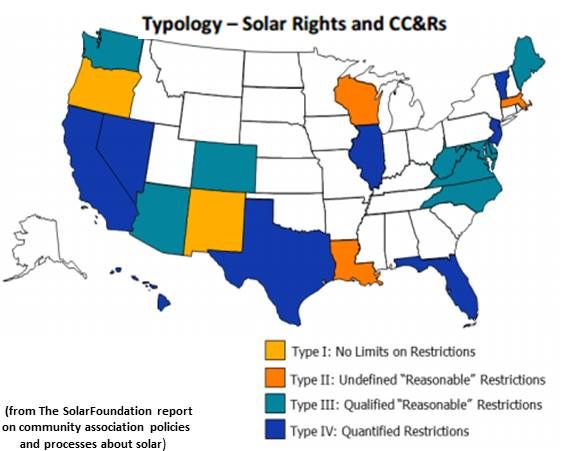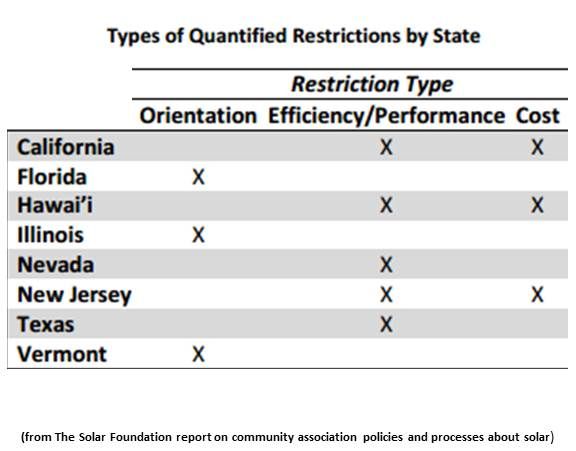Homeowners’ right to solar and the solar industry’s fight to cut rooftop solar soft costs could both get a boost from a new effort to educate neighborhood associations.
“This makes the case for solar directly to homeowner association (HOA) members and their review committees,” explained author Philip Haddix of The Solar Foundation’s report, A Beautiful Day in the Neighborhood: Encouraging Solar Development through Community Association Policies and Processes. “It tells them how they can allow more solar while fulfilling their responsibility to protect community interests and without ceding their authority.”
This issue is a subset of the soft cost discussion, Haddix said. “It is not quantified in the studies on soft costs but it is a permitting or planning and zoning issue. If there was a way to quantify this as a cost, it would be in the time lost dealing with the HOA.”
The opportunity is big. There are over 25 million housing units in HOA-governed communities and 52 percent of them (13 million) are suitable for residential solar, according to the report. An average-size solar system on just 5 percent of them would be “3.3 gigawatts, as much solar energy as was added in the entire U.S. in 2012.”
The major HOA concerns are:
- Community aesthetics
- Tree preservation and planting
- Health and safety
- Array size
- Array orientation
- Array tilt
- System shading
Difficulties arise from people not knowing about HOA restrictions, deciding to ignore them, or not knowing on what basis the HOA will judge the system, Haddix said. In some cases, a dispute can result in a lawsuit.
Whether an HOA is pro-solar or flat out against it, Haddix said, rules that are clearly delineated produce a better outcome.
There are Solar Rights Provisions in twenty-two states, Haddix said. Though far from standardized, provisons help guide HOAs. “Generally, people are better off with solar rights laws because they don’t allow HOAs to prohibit solar,” Haddix said. “The homeowner automatically has the right to have a solar system.”

Solar Rights Provisions fall into four broad categories:
- Type I: No Limits on Restrictions
- Type II: Undefined “Reasonable” Restrictions
- Type III: Qualified “Reasonable” Restrictions
- Type IV: Quantified Restrictions
Type III is slightly more common. Type IV, which quantifies restrictions, is better, according to Haddix, but Arizona’s Type III Provision proved important in a recent court fight:
“In Garden Lakes Community Association vs. William Madigan, et al., the Arizona Court of Appeals found that the association’s requirement that homeowners adopt (what were ultimately considered) impractical or costly placement and screening measures 'effectively prohibited' the installation and use of a solar energy system, even though solar was not expressly prohibited by the community’s architectural guidelines.”
“The Court said the rule had the effect of prohibiting solar,” Haddix explained, “and the Arizona solar rights provision says an association can make ‘reasonable restrictions’ but can’t make rules that ‘effectively prohibit’ solar.”
Common elements in Solar Rights Provisions include:
- Statement of Legislative Intent
- Voiding Prohibitions Against Solar
- Allowable Restrictions
- Applicability to Structures
- Awarding of Attorney’s Fees
- Grandfathering Clause
- HOA Policy Creation Mandate
- No Avoidance or Delay
- Provisions for Ground-Mounted Systems
The paper makes three recommendations for HOAs:
- Improved processes and rules through understanding solar and how restrictions can negatively affect system performance
- Improved clarity, specificity, and accessibility of association solar guidelines
- Stakeholder meetings to produce practical guidelines that reflect community needs and values
“The bottom line,” Haddix said, “is that informed, well-crafted, and clearly written guidelines for solar can allow more solar and minimize solar-related disputes between homeowners and HOAs while at the same time protecting other legitimate community interests and without requiring HOAs to cede their governance authority.”




